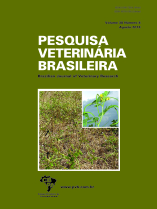 |
|
|
|
Year 2018 - Volume 38, Number 8
|

|
Epidemiological, clinical and pathological aspects of infectious canine hepatitis: 15 cases, 38(8):1608-1614
|
ABSTRACT.- Souto E.P.F., Maia L.A., Ferreira J.S., Gomes L.C.V.M., Carneiro R.S., Driemeier D., Souza A.P. & Dantas A.F.M. 2018. [Epidemiological, clinical and pathological aspects of infectious canine hepatitis: 15 cases] Aspectos epidemiológicos, clínicos e anatomopatológicos da hepatite infecciosa canina: 15 casos. Pesquisa Veterinária Brasileira 38(8):1608-1614. Laboratório de Patologia Animal, Hospital Veterinário, Centro de Saúde e Tecnologia Rural, Universidade Federal de Campina Grande, Campus de Patos, Av. Universitária s/n, Bairro Santa Cecília, Patos, PB 58708-110, Brazil. E-mail: dantas.af@pq.cnpq.br
We described the main epidemiological, clinical and pathological aspects of canine infectious hepatitis diagnosed in the Laboratory of Animal Pathology of the Federal University of Campina Grande during the period from January 2003 to December 2016. Of the 1,640 necropsied dogs, 15 were diagnosed as infectious canine hepatitis (0.91%). Of the dogs affected nine were males and six females. The ages ranged from 45 days to seven years, being most of them young. Ten animals were mixed breed, four were Poodles and one Rottweiler. Most of the dogs do not received any vaccine protocol. The dogs came from the municipalities of Patos, São Mamede and Teixeira, from Paraiba, northeastern of Brazil. Most of the dogs presented clinical course varying from hyperacute to acute. The main clinical signs were seizure, apathy and hyporexia. At necropsy, the major alterations were observed in the liver, which was pale to orange and with irregular reddish areas on the capsular surface, besides accentuation of the lobular pattern and edema in the wall of the gallbladder. Hemorrhages were observed in several organs. In the histopathology there was centrolobular necrosis of hepatocytes associated with intranuclear viral inclusion bodies, hemorrhages and mixed inflammatory infiltrate. The diagnosis was established based on the characteristic histopathological lesions and was confirmed by immunohistochemistry. Infectious canine hepatitis occurs occasionally in the Paraiba, affecting particularly young and unvaccinated dogs. |
| |
|
|
| |
|
 |